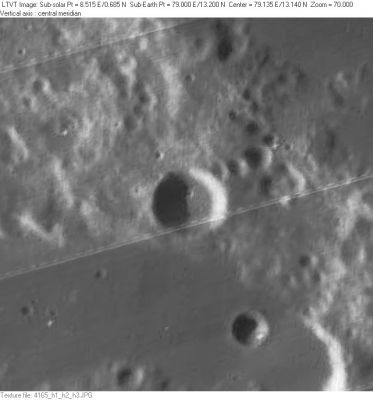Difference between revisions of "Sabatier"
| Line 6: | Line 6: | ||
|} | |} | ||
<div id="toc"> | <div id="toc"> | ||
| − | [http://lpod.org/coppermine/albums/userpics/Sabatier_LO-IV-165H_LTVT.JPG [[Image: | + | [http://lpod.org/coppermine/albums/userpics/Sabatier_LO-IV-165H_LTVT.JPG [[Image:Normal_Sabatier_LO-IV-165H_LTVT.JPG|external image normal_Sabatier_LO-IV-165H_LTVT.JPG]]]''[http://lpod.org/coppermine/displayimage.php?pos=-2417 LO-IV-165H]''<br /> Small crater '''Sabatier''''s location; very near the officially unnamed mare patch which is nowadays known as the "smiling mouth" of '''''Lacus Risus Felis''''' (see '''Nomenclature''' section below).<br /> <br /> |
==Images== | ==Images== | ||
[http://www.lpod.org/coppermine/thumbnails.php?album=search&type=full&search=Sabatier LPOD Photo Gallery] [http://www.lpi.usra.edu/resources/lunar_orbiter/bin/srch_nam.shtml?Sabatier%7C0 Lunar Orbiter Images] [http://www.lpi.usra.edu/resources/apollo/search/feature/?feature=Sabatier Apollo Images]<br /> A fully illuminated '''Sabatier''' was captured at (or very near) the central parts of Apollo 17's orbital ''ITEK''-panoramic frames [http://www.lpi.usra.edu/resources/apollo/frame/?AS17-P-2179 AS17-P-2179] and [http://www.lpi.usra.edu/resources/apollo/frame/?AS17-P-2184 AS17-P-2184]. In these frames, '''Sabatier''' is the crater with high-albedo inner slopes. The eastern (or "lower") part of '''Sabatier''''s rim is "touching" the lower margin of both frames.<br /> Research: Danny Caes<br /> <br /> | [http://www.lpod.org/coppermine/thumbnails.php?album=search&type=full&search=Sabatier LPOD Photo Gallery] [http://www.lpi.usra.edu/resources/lunar_orbiter/bin/srch_nam.shtml?Sabatier%7C0 Lunar Orbiter Images] [http://www.lpi.usra.edu/resources/apollo/search/feature/?feature=Sabatier Apollo Images]<br /> A fully illuminated '''Sabatier''' was captured at (or very near) the central parts of Apollo 17's orbital ''ITEK''-panoramic frames [http://www.lpi.usra.edu/resources/apollo/frame/?AS17-P-2179 AS17-P-2179] and [http://www.lpi.usra.edu/resources/apollo/frame/?AS17-P-2184 AS17-P-2184]. In these frames, '''Sabatier''' is the crater with high-albedo inner slopes. The eastern (or "lower") part of '''Sabatier''''s rim is "touching" the lower margin of both frames.<br /> Research: Danny Caes<br /> <br /> | ||
| Line 16: | Line 16: | ||
[http://en.wikipedia.org/wiki/Sabatier_(crater) Sabatier]<br /> <br /> | [http://en.wikipedia.org/wiki/Sabatier_(crater) Sabatier]<br /> <br /> | ||
==Additional Information== | ==Additional Information== | ||
| − | Depth data from [[Kurt%20Fisher% | + | Depth data from [[Kurt%20Fisher%20Crater%20Depths|Kurt Fisher database]]<br /> |
* Westfall, 2000: 1.63 km | * Westfall, 2000: 1.63 km | ||
Although the formation called '''Sabatier''' seems to be one of the most unknown craters on the whole of the moon's surface, its position could be located rather quickly because of the proximity of '''''Lacus Risus Felis''''' (the cluster of dark lakes which was never officially named by the IAU, but... received an unofficial and well-recognizable nickname by Charles Wood!).<br /> '''Sabatier''''s location is very near the southern part of the "smiling mouth" of '''''Lacus Risus Felis'''''. Research: Danny Caes<br /> <br /> | Although the formation called '''Sabatier''' seems to be one of the most unknown craters on the whole of the moon's surface, its position could be located rather quickly because of the proximity of '''''Lacus Risus Felis''''' (the cluster of dark lakes which was never officially named by the IAU, but... received an unofficial and well-recognizable nickname by Charles Wood!).<br /> '''Sabatier''''s location is very near the southern part of the "smiling mouth" of '''''Lacus Risus Felis'''''. Research: Danny Caes<br /> <br /> | ||
Latest revision as of 03:15, 16 April 2018
Contents
Sabatier (at Lacus Risus Felis)
|
Lat: 13.2°N, Long: 79.0°E, Diam: 10 km, Depth: 1.63 km,Rükl: 38 |

Small crater Sabatier's location; very near the officially unnamed mare patch which is nowadays known as the "smiling mouth" of Lacus Risus Felis (see Nomenclature section below).
Images
LPOD Photo Gallery Lunar Orbiter Images Apollo Images
A fully illuminated Sabatier was captured at (or very near) the central parts of Apollo 17's orbital ITEK-panoramic frames AS17-P-2179 and AS17-P-2184. In these frames, Sabatier is the crater with high-albedo inner slopes. The eastern (or "lower") part of Sabatier's rim is "touching" the lower margin of both frames.
Research: Danny Caes
Maps
Description
Description: Wikipedia
Additional Information
Depth data from Kurt Fisher database
- Westfall, 2000: 1.63 km
Although the formation called Sabatier seems to be one of the most unknown craters on the whole of the moon's surface, its position could be located rather quickly because of the proximity of Lacus Risus Felis (the cluster of dark lakes which was never officially named by the IAU, but... received an unofficial and well-recognizable nickname by Charles Wood!).
Sabatier's location is very near the southern part of the "smiling mouth" of Lacus Risus Felis. Research: Danny Caes
Nomenclature
Paul Sabatier (November 5, 1854 – August 14, 1941) was a French chemist. Sabatier greatly facilitated the industrial use of hydrogenation. In 1897, he discovered that the introduction of a trace of nickel as a catalyst facilitated the addition of hydrogen to molecules of carbon compounds. He won the Nobel Prize in Chemistry jointly with fellow Frenchman Victor Grignard in 1912.
LPOD Articles
Bibliography